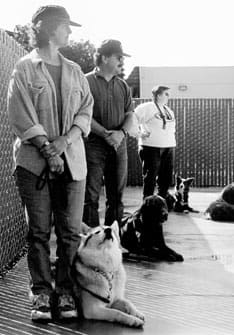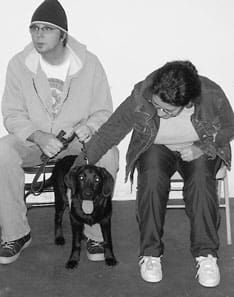Men are from Mars. Women are from Venus. Dogs are from Neptune. A well-known trainer recently made a public comment about men’s inability to act silly with their dogs, to the detriment of their ability to use positive training methods effectively.
Are we really three alien species, destined to live forever in a world of miscommunication and misinterpretation? Is one gender truly better suited to bridge the communication gap between the human and canine species? We fervently hope the answer to the first question is “No!” – and strive to offer Whole Dog Journal readers new information and resources every month to help cross the species barrier. If the 38 trainers who responded to our casual survey on this topic are right, the answer to the second question may be, “Not better, just different!”

For starters, it appears that women are significantly overrepresented, at least in the positive dog-training community, which is where we posed our questions. In a survey of its members a few years ago, the Association of Pet Dog Trainers, then about 3,000 strong, found that approximately 80 percent of its membership was female. Respondents to our recent questionnaire were 95 percent female (36 of 38). Here are some of their thoughts on the subject of men versus women in the pet-dog training world.
———-
Question: Among your clients, what approximate percentage are male and what percentage are female?
Answer: Women appear to be overrepresented on the client side of the equation as well as the professional side, although not as overwhelmingly – about 2 to 1 instead of close to 20 to 1. One trainer responded that her clientele was 50/50 male and female. The rest were heavy on the side of female clients, ranging from 60 to 98 percent women. The average of all the answers was 68.8 percent female, 31.2 percent male.
Are there generalizations you would make about the differences between the training styles of men and women?
The general consensus was that women are less likely to use force, are more verbal, more patient, better at listening to instruction, more willing to follow instruction, better at paying attention to and reading dog body language, more supportive of the concept of force-free training – and less likely to be consistent and structured in their training. Trainers noted that men are more likely to want fast results, more apt to use physical strength, more likely to participate in discussions, more interested in “how” than “why” – and less willing to use animated body language and “happy voice.”
Trainer comments
• Kathie Compton, mARFa Dog Training, Marfa, TX: “Generally, men tend to be more reluctant to give enthusiastic praise and are less animated with their dogs. Men and women take to positive training about equally, but women seem to have an innate understanding of the concept – perhaps because they value the importance of communication in a relationship and tend to be primary caretakers.”
• Maggie Blutreich, CPDT, Bravo! Force-Free Training, Wingate, NC: “Women seem more flexible and patient, able to assess many options before arriving at an action or conclusion. Some men seem less able to reward successive approximations – waiting for or even insisting on the entire behavior to manifest before marking and rewarding. Also, men can be quicker to physically react.”
• Susan Shaulis, Cedarwater Dog Training, Germantown, MD: “I think it’s more that men and women have a different way of going about things. Men have an easier time becoming the pack leader and disciplining, and women have an easier time praising and relaxing the dog.”
• Ritsa Larkin, CPDT, Happy Hounds Dog Training, Selden, NY: “I need to encourage men more to find their ‘inner happy voice’ and not be so monotone when communicating with their dogs. I sometimes need to remind women not to use so many words – they can have conversations with their dogs all day (I know I do) – but in training, simple and concise is best.”
Do you tend to teach men differently from women? If so, what are the differences?
Answers to this question varied, but the majority of the trainers who responded emphasized that they try to use teaching styles based on individual needs rather than gender assumptions. This speaks well for the pet-dog training profession, and is a pronounced change from old-fashioned training methods, where there was usually one way to do things and you were expected to do them that way, regardless of your own (or your dog’s) learning style and personality, or relationship with your dog.
• Felicia Monteforte, MVP Dog Training, Sayreville, NJ: “I don’t look at gender when training, I look at personality and go from there. If there are differences, it would generally be to have men try to loosen up a bit, and teach the women how to click with long nails.”
• Susan Brumbelow, CPDT, Douglasville, GA: “I’m not aware of differences in my training methods based on gender. But I do vary my methods based on an individual’s skill, coordination, and patience.”
• Ann Dupuis, Your Dream Dog, Randolph, MA: “I try to tailor my teaching style to each individual. Some people want to see something demonstrated multiple times before they try it; others like to jump right in and try it out. Some really appreciate learning the why’s and how’s behind what I’m teaching; others just want to see it work. I haven’t noticed any quantifiable differences based on gender.”
• Marni Fowler, CPDT, Class Act for Dogs, Gainesville, FL: “I may be a little more touchy-feely with my comments and praise when it comes to women. I may tend to make more comments on how cute the dog is, whereas with a man I may comment more on the dog’s cleverness or physical fitness. But it really depends on the individuals as to what I think would work better for them.”
• Mary Elizabeth Van Everbroeck, Pet Guardian Education and Animal Advocacy Services, Inc., Warminster, PA: “Yes, men are results-oriented and tend to become bored more quickly than women. I tailor my instruction to accommodate this difference between the sexes. Men are generally more apt to be ‘focused’ while women are more ‘contextual.’ Effective instruction requires an appreciation for both skills in order to help pet owners and their dogs.”
• Peg Dawson Harrington, The Happy Hound, Nashville, TN: “I’m not really conscious of teaching differently; the physical stuff is the same. I do use different analogies when speaking to men; I’ll liken clicker training to ‘just another video game.’ And then there’s the ‘spit the treats into the dog’s mouth’ thing that doesn’t go over as well with my women clients, but the guys – for the most part – seem to like it.”
Do you find that it’s easier for men or women to learn clicker skills, or about the same?
Trainers were all over the map on this one. Many found gender-linked clicker skills to be about the same. Others found distinct differences. This supports the concept that training skills are less about gender and more about individual personality and ability.
• Jo Jacques, WiggleBums! Dog-Friendly Training & Behavior Counseling, Salem, MA: “About the same, but I find women tend to stick with it longer.”
• Mary Lou Carroll, Puppy-Luvs Dog Training, Elizabeth City, NC: “Women generally seem to pick up on the timing more quickly. Perhaps their observational skills tend to be a little better, on average? Men seem to fumble more with all the ‘stuff’ – clicker, gear, treats, etc.”
• Jim Barry, Rhode Island Dog Guy, Middletown, RI: “This seems not particularly related to gender but rather to manual dexterity, which is gender-neutral. I do find that probably a higher percentage of women are open to carrying a clicker around, and young men in particular seem to find it a little ‘dorky.’ ”
• Sabine Hentrich, Four Positive Paws LLC, Greenbelt, MD: “For whatever reason, in my experience men tend to be better at learning clicker skills. They can be faster, have better timing in general, and are good at observing their dogs. They also tend to be less inhibited about making mistakes and can laugh at their own blunders more easily than their female partners. The clients I have the most trouble with are elderly female clients, and I frequently encourage them to use a verbal marker instead.”
• Pam Parrish, Pamadona Weimaraners/Weimaraner Rescue of the South, Huntsville, AL: “Men seem to be intimidated by the clicker. I suggest they use a voice marker instead, and they seem to like that better.”
If you use a marker other than the clicker, do you find that it’s easier for men or women to learn the marker skills, or about the same?
With verbal marker skills, there seemed to be more of a consensus among trainers that gender doesn’t seem to matter.
• Frances Dauster, CPDT, P’s and Q’s Dog Training! LLC, Grand Bay, AL: “About the same. It seems like the men work harder at good timing, whereas the women more often have it naturally.”
• Elaine Berg, Golden Rule Dog Training, Keller, TX: “I have found women will try harder to remember the verbal marker than men – at least in front of me. I don’t know what happens when they are doing their homework.”
• Ann King, Canine King, Yonkers, NY: “I truly believe this one is dependent on the individual. Although, I often wonder though if I changed my marker word from ‘Yes!’ to ‘Score!’ if it would be a breeze for men to mark the behavior…”
• Margaret A. Johnson, CPDT, CC-SF SPCA, The Humaner Trainer, Austin, TX: “I think people are all over the map on this one. Doesn’t seem to matter if they are men, women, engineers, artists… It’s who has the best observational skills and timing. The best person I’ve had was a deaf student – probably because she reads a lot of body language when interpreting the world. Next best are kids.”
Is there anything else you’d like to say on the topic of Men v. Women in dog training?
• Silvia Golz, CPDT, Best Friends Companion Dog Training, Appleton, WI: “I think that the women clients take a woman trainer more seriously than they would a male, and vice versa for the men. My male clients tend to be the “Yes, but . . .” clients more so than the women.”
• Bea Pludow, CPDT, Canine Behavior Specialist, El Cajon, CA: “Women generally appear less dangerous to dogs. Men generally appear more dangerous, in my experience, because there are fewer of them involved in the training and socialization process, and they are bigger and stronger-sounding and -smelling than females. Although I have met some ‘really dangerous’ women trainers!”
• Ali Brown, CPDT, Great Companions, Slatington, PA: “I only wish I saw more men in the rally ring, the agility ring, and in my classes.”
• Lisa Giesick, CPDT, Ohana Pet, Marina, CA: “I think it would be wonderful to have more men as positive trainers. If more men embraced positive training, I think it would get rid of the thinking that positive trainers are ‘foo foo’ trainers who are just afraid to show their dog who is boss!”
• Joan Hunter-Mayer, CTC, The Inquisitive Canine LLC, Ventura, CA: “As long as there is a constant increase in positive reinforcement methods and a decrease in aversive techniques, I don’t care about the gender of the trainer, human client, or poochie client.”
Supported by science
So there you have it: an industry-insider look at the differences between the sexes as we relate to our canine companions. Is there any scientific basis to our perceived differences? One list reader sent us this quote from Mind Wide Open, a book about the physiological differences between male and female brains:
“It is inevitable that natural selection would craft slightly different toolboxes for each sex. Viewed with modern imagining technologies, men’s and women’s brains are nearly as distinct from each other as their bodies are. They have reliably different amounts of neurons and gray matter; some areas linked with sexuality and aggression are larger in men than in women; the left and right hemispheres are more tightly integrated in women than in men. And of course, those brains – and the bodies they are attached to – are partially shaped by the two different kinds of hormones, the androgens and estrogens, which play a key role both in development and adult life experiences.”
Modern, positive trainers strive to base their training programs on scientific data rather than anecdotal evidence alone. The information provided by imaging technologies affirms and supports professional intuition regarding gender-related differences in training.
The trainers we surveyed were aware of and receptive to the idea of sex-based differences in training; dog training is clearly as much about people as it is about dogs. Trainers who are aware of gender tendencies can watch for them and use them to everyone’s advantage when working with human clients. Even better are trainers, such as those we surveyed, who can use gender tendencies to best advantage while also working with the learning styles and skills of each dog owner as an individual, not as a stereotype. The best of both worlds!






Great information!
The question people most often ask me is “How do I stop my dog from jumping?” The second most frequently asked question is, “How can I become a professional dog trainer?”
Before making any life-altering decisions, I always advise people to first ask themselves not “how” to become a trainer, but first, “why?” There are excellent reasons to join this profession. Then there are not-so-good reasons.